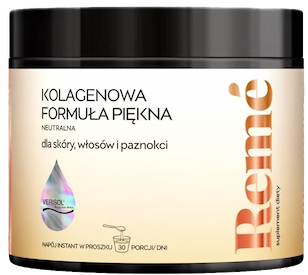Tennis elbow: symptoms, treatment, exercises, home remedies
Learn about the symptoms, causes and treatments for painful tennis elbow.


Learn more about our editorial process
.

Learn more about our editorial process
.

Learn more about our editorial process
.

Learn more about our editorial process
.
Why you can trust us
Articles on Natu.Care are written based on scientific research, data from government websites and other reliable sources. The texts are written in cooperation with doctors, nutritionists and other health and beauty experts. Articles are reviewed before publication and during significant updates.
.Learn more about our editorial process
.Information about advertisements
Content on Natu.Care may contain links to products from the sale of which we may receive a commission. When creating content, we adhere to high editorial standards and take care to be objective about the products discussed. The presence of affiliate links is not dictated by our partners, and we select the products we review ourselves completely independently.
.Learn more about our terms and Conditions
.You can't lift a coffee mug normally, and the thought of cleaning windows makes you weak. Pain accompanies you with most activities of daily living. This is the reality for sufferers of tennis elbow.
.
Wondering why you have tennis elbow if you have never held a racket in your life? The name is misleading, and enthesopathy of the wrist extensor muscle attachment is most commonly suffered by... office workers, mechanics, carpenters, dentists and cleaners.
Tennis elbow is a common name for tennis elbow.
From this article you will learn:
- What tennis elbow is and where it comes from.
- What the symptoms of tennis elbow are.
- What are the symptoms of this ailment. .
- Which treatments are the most effective.
- What are the most effective treatments?

Sprawdź, jak może on zadbać o zdrowie Twoich stawów i urodę! Kolagen Premium (10 000 mg) wiśnia
Natu.Care Kolagen Premium Sport 10000 mg, wiśnia
Natu.Care Kolagen Premium dla zdrowia stawów, skóry, paznokci i włosów. Wołowy kolagen w optymalnej dawce 10 000 mg. Przebadany przez niezależne laboratorium.
Sprawdź cenę
Ten kolagen dobrze się rozpuszcza, super smakuje – jak taki soczek wiśniowy. Moje włosy przestały wypadać, są gęstsze i zdrowsze a cera promienna.@Dominika P.
See also:
.
- Best collagen for tennis elbow .
- Best collagen for tendons
- Best collagen for joints
- Best collagen for bones
- Collagen for athletes
- Grandmother's ways for joints .
What is tennis elbow?
.
To understand what the ailment commonly known as tennis elbow is, it is necessary to look at the structure of the elbow (or more correctly: the elbow joint).
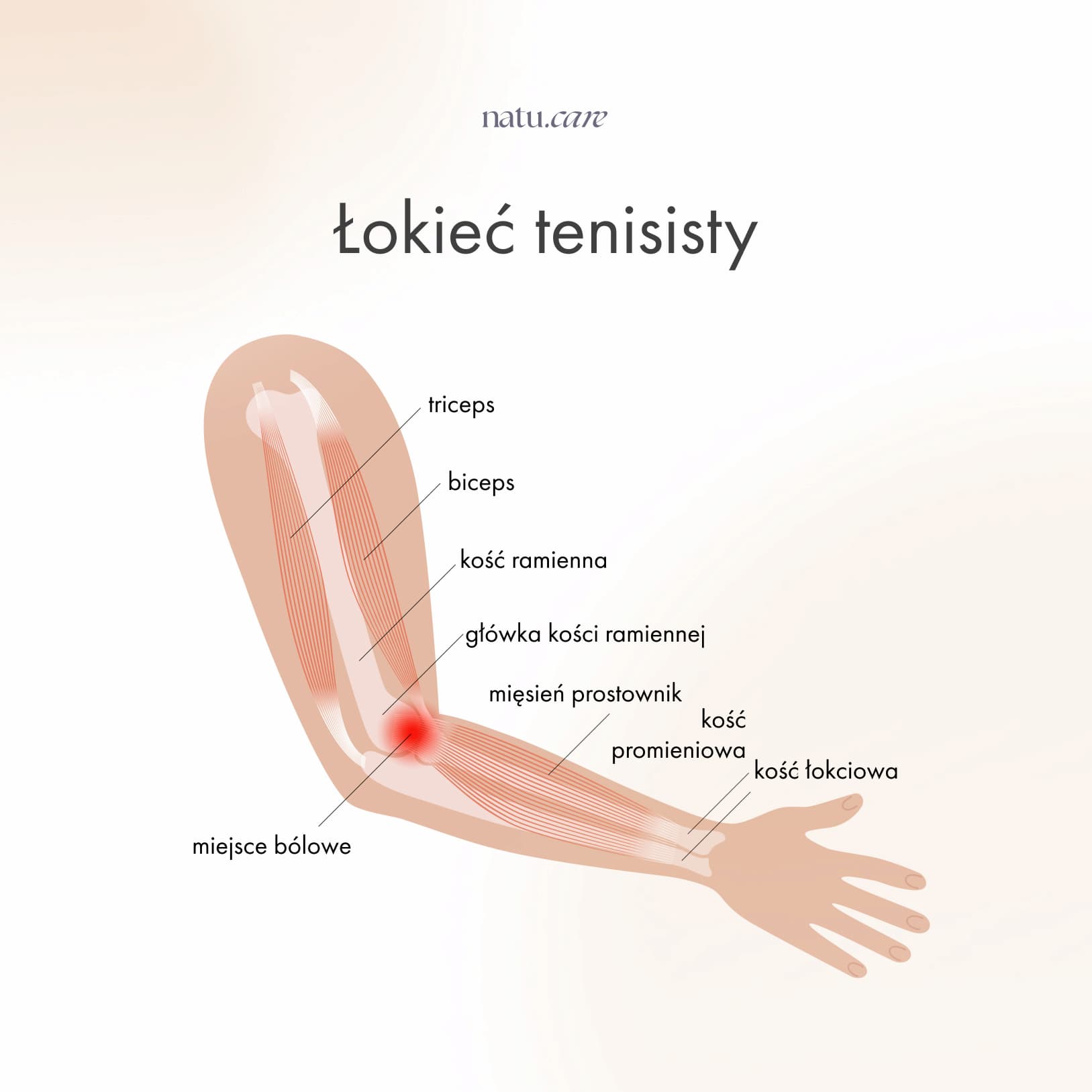
The elbow is the junction of the humerus and elbow bones. They are connected by a joint that allows the forearm to move. At this point, the humerus has a protrusion which is called the lateral epicondyle. It is to this that the extensor muscles of the wrist and fingers attach. The place where the muscles attach to the bone is the tendonand.
Tennis elbow is nothing more than a degeneration of the tendon of the wrist extensor muscles. To be medically correct, we refer to an enthesopathy of the attachment of these muscles .
Tennis elbow versus golfer's elbow
.
Tennis elbow and golfer's elbow are distinguished from each other by the site of tendon degradation. In the case of tennis elbow, this involves the tendon of the extensor muscles of the wrist attached to the lateral epicondyle of the humerus, which is located on the external side of the joint. With golfer's elbow, the condition affects the tendon on the inside of the elbow - attached to the medial epicondyle of the humerusand.
Poor these athletes, you play tennis - tennis elbow, you switch to golf - golfer's elbow. It's lucky there's no office worker's elbow. Well, not necessarily... Both of these ailments mainly affect people who spend a lot of time at the computer. As far as athletes are concerned, they most often affect those who have not yet practised proper hitting techniqueand.
Causes of tennis elbow
.
The cause of tennis elbow is the occurrence of multiple micro-injuries to the tendon over an extended period of time. These micro-injuries lead to the destruction of the muscle attachment by degeneration of the collagen fibresand.
Microtrauma occurs as a result of repetitive movements of the wrist in dorsiflexion. Some of these include operating a computer mouse, driving screws or turning up the ball in tennis.
Long periods of holding the wrist in flexion (and putting extra pressure on the surface with the hand) can also contribute to this condition. This is why it often occurs in professional cleaners.
The condition is also common.
Symptoms of tennis elbow
.
The symptom of tennis elbow is chronic pain on the outside of the elbow joint. It very often intensifies when moving the hand or (more typically) clenching the hand into a fistand.
.
Also, the pain may radiate to the forearm or even to the wrist itself. In later stages, the condition can also cause limited mobility of the elbow joint and even problems with grasping and lifting everyday objects .
The radial nerve can be irritated by local muscle friction or local inflammation. And in this anatomical region, the posterior intercostal nerve is formed from the radial nerve. Compression and irritation of this nerve causes Ulnar Canal Syndrome, the symptoms of which are similar to tennis elbow, and sometimes both complaints occur together..
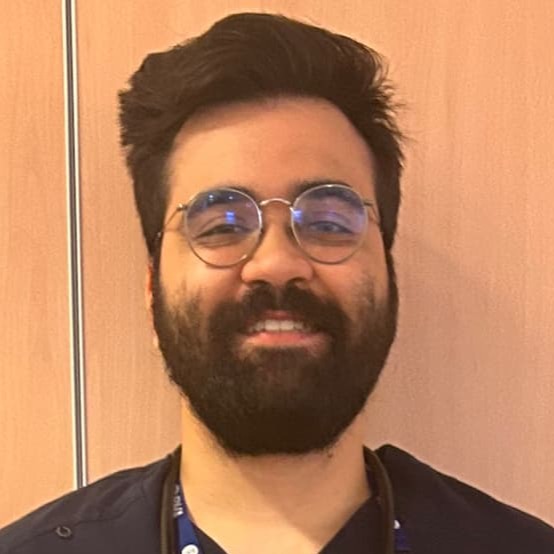 .
.
Kacper Nihalani doctor
Interesting fact
.It is estimated that tennis elbow can affect around 40% of the population. It most commonly affects people aged 35-54and.
Test for tennis elbow
.
To diagnose tennis elbow, orthopaedic surgeons and physiotherapists use several tests, which involve positioning the hand appropriately and subjecting it to some resistance or, movement or pressure. Tennis elbow is diagnosed by, among other testsand:
- Cozena, .
- Mill, .
- Thompson, .
- Maudsley, .
More often than not, a specialist will apply more than one of the tests listed above by conducting a manual examination.
During the examination, the pain is usually worst 1-2 cm from the radial extensor short wrist attachment..
 .
.
Kacper Nihalani doctor
.
How to cure tennis elbow
.
To cure tennis elbow, it is best to eliminate the cause of the micro-injury. Unfortunately, this is often not possible (it is difficult to change from one occupation to another overnight). Temporarily restricting the wrist movements that cause the tendon to degenerate will also help - you can get temporary sick leave for tennis elbow.
If your discomfort is caused by working at a computer, specialists recommend using a vertical computer mouse or suitable silicone pads. This will help to position your wrist in a more comfortable position.
Home remedies for tennis elbow include cold compresses, cabbage compresses and appropriate exercises - the effectiveness of these methods has been confirmed by research. Others include poultices made from vinegar, resinoid or plantain leaves, but here the therapeutic effect is not certain.
There are many methods to support tennis elbow.
There are many methods to help treat wrist extensor muscle attachment enthesopathy. Remember, however, not to treat on your own - the appropriate therapy should always be tailored for you by an expert: an orthopaedist or physiotherapist.
Tennis elbow ointments
.
Tennis elbow ointments and creams usually have an analgesic and anti-inflammatory effect. This means that they do not cure the disease, but only mask its symptom, which is pain. However, they can aid therapy and make your daily life easier.
Collagen supplementation for tennis elbow
.
Since tennis elbow is caused by the degradation of collagen fibres, why not supplement the body's collagen deficiency? Indeed, supplementation of collagen can help to renew its structures in the skin and reduce the risk of further damage.
For tendon problems, it is worth choosing a supplement of type I or type I and III collagen. Preferably in the form of a hydrolysate of fish origin, providing at least 5000 mg of collagen per daily serving. Choose supplements based on a readily available, high-quality formula, such as SeaGarden.
Natu.Care Collagen Premium 5000 mg, mango-maracuja

- Collagen content: 5000 mg marine collagen hydrolysate
- .
- Additional active ingredients: vitamin C, low molecular weight hyaluronic acid (and L-theanine and coenzyme Q10 in cocoa flavoured collagen or vitamin A and vitamin E in mango–passion fruit flavoured collagen)
- .
- Form: powder sachets
- .
- Dose: 1 sachet per day
- .
- Sufficient for: 30 days
- .
Product description
Fish collagen from the Natu.Care brand in a dose of 5000 mg. The formula contains a sufficient portion of the active substance to positively affect your joints, musculoskeletal system and immunity.
Take care of your tendons, joint cartilage, ligaments, muscles and even bones by supplying them with the building blocks to function properly. Move without bólu and provide the necessary support for any physical activity.
And as a „gratis” to regular supplementation, you will also receive firm skinóhand, healthy and shiny hair and strong nails.
Natu.Care Premium Collagen is available in two flavours – Cacao Bloom and Rise&Shine. Both formulas are based on the following active ingredients: marine collagen hydrolysate, wild roseóbud extract and hyaluronic acid.
Additionally, Cacao Bloom contains natural L-theanine, coenzyme Q10 and defatted Dutch cacao. Rise&Shine instead contains vitamin E and vitamin A.
These are the best collagens in the world.
These best fish collagens on the market also rós taste – Cacao Bloom is a treat for chocolate lovers. Rise&Shine will appeal to those whoóenjoy the refreshing taste of mangoófruit and passion fruit.
Pros and cons
Fish collagen from the Natu.Care brand in a dose of 5000 mg. The formula contains a sufficient portion of the active substance to positively affect your joints, musculoskeletal system and immunity.
Take care of your tendons, joint cartilage, ligaments, muscles and even bones by supplying them with the building blocks to function properly. Move without bólu and provide the necessary support for any physical activity.
And as a „gratis” to regular supplementation, you will also receive firm skinóhand, healthy and shiny hair and strong nails.
Natu.Care Premium Collagen is available in two flavours – Cacao Bloom and Rise&Shine. Both formulas are based on the following active ingredients: marine collagen hydrolysate, wild roseóbud extract and hyaluronic acid.
Additionally, Cacao Bloom contains natural L-theanine, coenzyme Q10 and defatted Dutch cacao. Rise&Shine instead contains vitamin E and vitamin A.
These are the best collagens in the world.
These best fish collagens on the market also rós taste – Cacao Bloom is a treat for chocolate lovers. Rise&Shine will appeal to those whoóenjoy the refreshing taste of mangoófruit and passion fruit.
Additional information
Fish collagen from the Natu.Care brand in a dose of 5000 mg. The formula contains a sufficient portion of the active substance to positively affect your joints, musculoskeletal system and immunity.
Take care of your tendons, joint cartilage, ligaments, muscles and even bones by supplying them with the building blocks to function properly. Move without bólu and provide the necessary support for any physical activity.
And as a „gratis” to regular supplementation, you will also receive firm skinóhand, healthy and shiny hair and strong nails.
Natu.Care Premium Collagen is available in two flavours – Cacao Bloom and Rise&Shine. Both formulas are based on the following active ingredients: marine collagen hydrolysate, wild roseóbud extract and hyaluronic acid.
Additionally, Cacao Bloom contains natural L-theanine, coenzyme Q10 and defatted Dutch cacao. Rise&Shine instead contains vitamin E and vitamin A.
These are the best collagens in the world.
These best fish collagens on the market also rós taste – Cacao Bloom is a treat for chocolate lovers. Rise&Shine will appeal to those whoóenjoy the refreshing taste of mangoófruit and passion fruit.
User review
Fish collagen from the Natu.Care brand in a dose of 5000 mg. The formula contains a sufficient portion of the active substance to positively affect your joints, musculoskeletal system and immunity.
Take care of your tendons, joint cartilage, ligaments, muscles and even bones by supplying them with the building blocks to function properly. Move without bólu and provide the necessary support for any physical activity.
And as a „gratis” to regular supplementation, you will also receive firm skinóhand, healthy and shiny hair and strong nails.
Natu.Care Premium Collagen is available in two flavours – Cacao Bloom and Rise&Shine. Both formulas are based on the following active ingredients: marine collagen hydrolysate, wild roseóbud extract and hyaluronic acid.
Additionally, Cacao Bloom contains natural L-theanine, coenzyme Q10 and defatted Dutch cacao. Rise&Shine instead contains vitamin E and vitamin A.
These are the best collagens in the world.
These best fish collagens on the market also rós taste – Cacao Bloom is a treat for chocolate lovers. Rise&Shine will appeal to those whoóenjoy the refreshing taste of mangoófruit and passion fruit.
Natu.Care Collagen Premium 10000 mg, cherry
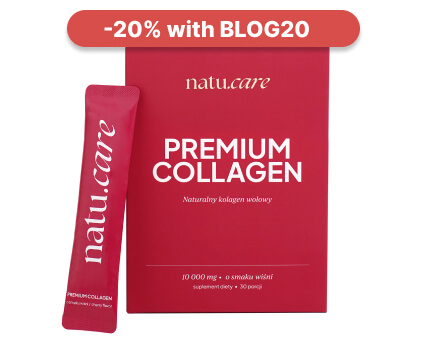
- Collagen content: 10,000 mg of hydrolyzed bovine collagen
- Additional active ingredients: vitamin C, low molecular weight hyaluronic acid, glucosamine, chondroitin, extract of Indian frankincense resin (boswellia serrata)
- Form: powder sachets for drinking
- Serving: 1 sachet per day
- Lasts for: 30 days
Product description
One of the strongest collagens on the market, providing as much as 10,000 mg per daily serving. This product can effectively support the condition of joints, skin, hair, and nails.
With this supplement, you will support your skeletal and joint system as well as your beauty, helping you visually halt the aging process and feel rejuvenated!
Pros and cons
Pros:
- The daily portion of collagen is very large – as much as 10,000 mg.
- Proven collagen formula – COLLinstant, whose effectiveness has been confirmed in clinical studies.
- Effective dose of hyaluronic acid, which additionally moisturizes the skin and positively affects joint health.
- Vitamin C supports the body's natural collagen production.
- Glucosamine is a fundamental building block of compounds found in joint cartilage and a component of collagen that gives elasticity to connective tissue in tendons.
- Chondroitin is a natural component found in the human body, mainly in cartilage. This large molecule (mucopolysaccharide) has the ability to absorb water, which helps maintain the elasticity and resilience of cartilage.
- Frankincense resin extract supports blood circulation and joint mobility and reduces their stiffness. It may help alleviate inflammatory conditions.
- The composition has been tested by the independent and accredited J.S. Hamilton laboratory.
Cons:
- None.
Additional information
Users praise Natu.Care Collagen Premium for the easy dissolving of the powder.
ALLDEYNN Collarose Fish

- Collagen content: 5000 mg hydrolysate fish collagen VERISOL F® .
- Additional active ingredients: vitamin C, hyaluronic acid, biotin
- Form: powder to dissolve in water .
- Dose: one scoop (6 g) of powder daily .
- Sufficient for: 50 days .
Product description
Atlantic cod collagen VERISOL F® contained in the formula are easily absorbed collagen peptides of fish origin. Regular supplementation can firm your skinóhand and slow down the ageing process. Your nails will become stronger and stop breaking. The addition of biotin will improve the condition of your hairów. The collagen portion is high enough to also have a good effect on your joints, muscles and bones.
Pros and cons
Atlantic cod collagen VERISOL F® contained in the formula are easily absorbed collagen peptides of fish origin. Regular supplementation can firm your skinóhand and slow down the ageing process. Your nails will become stronger and stop breaking. The addition of biotin will improve the condition of your hairów. The collagen portion is high enough to also have a good effect on your joints, muscles and bones.
Additional information
Atlantic cod collagen VERISOL F® contained in the formula are easily absorbed collagen peptides of fish origin. Regular supplementation can firm your skinóhand and slow down the ageing process. Your nails will become stronger and stop breaking. The addition of biotin will improve the condition of your hairów. The collagen portion is high enough to also have a good effect on your joints, muscles and bones.
Expert and user opinion
Atlantic cod collagen VERISOL F® contained in the formula are easily absorbed collagen peptides of fish origin. Regular supplementation can firm your skinóhand and slow down the ageing process. Your nails will become stronger and stop breaking. The addition of biotin will improve the condition of your hairów. The collagen portion is high enough to also have a good effect on your joints, muscles and bones.
DuoLife Collagen fish collagen 2500 mg

- Collagen content: 2500 mg collagen
- Additional active ingredients: vitamin C, silicon, glucosamine, hyaluronic acid, nettle and bamboo extracts
- Form: liquid to drink .
- Dose:25 ml .
- Sufficient for: 30 days .
Product description
100% natural collagen liquid without unnecessary ingredientsós. The composition of ingredientsós improves the appearance and condition of skinóry, hairów, nails. DuoLife is a good choiceór if you notice the first signs of skinóry ageing or want to stop this process. A tasty liquid, convenient to use.
Pros and cons
100% natural collagen liquid without unnecessary ingredientsós. The composition of ingredientsós improves the appearance and condition of skinóry, hairów, nails. DuoLife is a good choiceór if you notice the first signs of skinóry ageing or want to stop this process. A tasty liquid, convenient to use.
Additional information
100% natural collagen liquid without unnecessary ingredientsós. The composition of ingredientsós improves the appearance and condition of skinóry, hairów, nails. DuoLife is a good choiceór if you notice the first signs of skinóry ageing or want to stop this process. A tasty liquid, convenient to use.
User review
100% natural collagen liquid without unnecessary ingredientsós. The composition of ingredientsós improves the appearance and condition of skinóry, hairów, nails. DuoLife is a good choiceór if you notice the first signs of skinóry ageing or want to stop this process. A tasty liquid, convenient to use.
Pharmovit liquid collagen 10000 mg
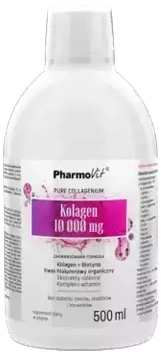
- Collagen content: 10000 mg hydrolysed bovine collagen types I and III .
- Additional active ingredients: hyaluronic acid, natural plant extracts, vitamin C, B vitamins, zinc, vitamin D
- Form: vials .
- Dose: 25 ml .
- Sufficient for: 20 days .
Product description
A solid daily dose of collagen for jointómuscle and bone health and beauty. The duo of collagen and vitamin C has a positive effect on each other, so that „the protein of youth” is better absorbed and more efficiently produced in the body.
Pros and cons
A solid daily dose of collagen for jointómuscle and bone health and beauty. The duo of collagen and vitamin C has a positive effect on each other, so that „the protein of youth” is better absorbed and more efficiently produced in the body.
Additional information
A solid daily dose of collagen for jointómuscle and bone health and beauty. The duo of collagen and vitamin C has a positive effect on each other, so that „the protein of youth” is better absorbed and more efficiently produced in the body.
KFD Premium Collagen+
Product description
High dose of collagen and a real bomb of vitamins C and D and organic sulphur. With this preparation the effects will come immediately. You will improve the firmness of your skin and reduce wrinkles. Your hair and nails will be strong and shiny.
A generous dose of collagen will improve the mobility of your jointsós, benefit your bone system and muscles. Do you do sports and need a product thatós able to keep up with your needs? This product will do the trick.
Pros and cons
High dose of collagen and a real bomb of vitamins C and D and organic sulphur. With this preparation the effects will come immediately. You will improve the firmness of your skin and reduce wrinkles. Your hair and nails will be strong and shiny.
A generous dose of collagen will improve the mobility of your jointsós, benefit your bone system and muscles. Do you do sports and need a product thatós able to keep up with your needs? This product will do the trick.
Additional information
High dose of collagen and a real bomb of vitamins C and D and organic sulphur. With this preparation the effects will come immediately. You will improve the firmness of your skin and reduce wrinkles. Your hair and nails will be strong and shiny.
A generous dose of collagen will improve the mobility of your jointsós, benefit your bone system and muscles. Do you do sports and need a product thatós able to keep up with your needs? This product will do the trick.
Expert opinion
High dose of collagen and a real bomb of vitamins C and D and organic sulphur. With this preparation the effects will come immediately. You will improve the firmness of your skin and reduce wrinkles. Your hair and nails will be strong and shiny.
A generous dose of collagen will improve the mobility of your jointsós, benefit your bone system and muscles. Do you do sports and need a product thatós able to keep up with your needs? This product will do the trick.
Product description
The dietary supplement from Remé contains beef collagen in a patented formula and vitamin C, whichóra aids its absorption. The formula comes in three flavours: neutral, orange-maracuja and strawberry-pomegranate. The formula can effectively support and improve the condition of the skinóry, hairóry and nails.
Pros and cons
The dietary supplement from Remé contains beef collagen in a patented formula and vitamin C, whichóra aids its absorption. The formula comes in three flavours: neutral, orange-maracuja and strawberry-pomegranate. The formula can effectively support and improve the condition of the skinóry, hairóry and nails.
Additional information
The dietary supplement from Remé contains beef collagen in a patented formula and vitamin C, whichóra aids its absorption. The formula comes in three flavours: neutral, orange-maracuja and strawberry-pomegranate. The formula can effectively support and improve the condition of the skinóry, hairóry and nails.
The dietary supplement from Remé contains beef collagen in a patented formula and vitamin C, whichóra aids its absorption. The formula comes in three flavours: neutral, orange-maracuja and strawberry-pomegranate. The formula can effectively support and improve the condition of the skinóry, hairóry and nails.
Tennis elbow brace
.
Bands, orthoses and stabilisers are medical devices used to relieve pressure on muscle attachments. Some models also exert variable pressure on the affected area, which is somewhat similar to a massage and promotes muscle relaxation.
Taping for tennis elbow
.
Taping (actually kinesiotaping) has recently become very fashionable, especially among athletes. Special tapes are stuck along the muscle fibres, in a position of maximum stretch. Their purpose is to reduce muscle tension.
This can alleviate pain, but does not assist the muscle in performing movements. This technique can be used adjunctively, but will not cure tennis elbow on its own.
The technique can be used as an aid, but will not cure tennis elbow on its own.
Exercises for tennis elbow
.
Rehabilitation can improve joint mobility and strengthen muscles. Properly conducted exercises can also promote muscle relaxation.
Interestingly, there is still no clear evidence in scientific studies to support the effectiveness of exercise programmes in treating the pain and functional problems associated with tennis elbowand.
Is it not worth exercising then? It is worth it, but it is best done to prevent the condition. If you are at increased risk of tennis elbow, it is recommended that you do simple exercises to stretch the wrist extensor muscles. For example, you can straighten your arm at the elbow, lift your fingers up and gently press them together, or bend and straighten your wrists from time to time.
It is also very helpful to roll the extensors, i.e. rolling the forearm with a special roller. Guide the roller with even pressure from the wrist up to the elbow and back.
Rollers are also very helpful.
Shockwave for tennis elbow
.
Shockwave is a safe and non-invasive treatment that is widely used to treat orthopaedic conditions. It involves the application of a special head to the painful area, which generates an acoustic wave of high, surging pressure. This wave penetrates the body to a depth of several centimetres.
Results from several studies conducted between 2018 and 2021 suggest that the shock wave can improve grip strength in patients suffering from tennis elbow. Some of the studies have also shown an effect on pain reduction, but on this subject the conclusions are not consistentand.
Injections for tennis elbow
.
Among the injections used to treat tennis elbow, the most common are injections of platelet-rich plasma or corticosteroids (known as blockade).
Corticosteroids have an analgesic effect and fight inflammation, but do not contribute to the regeneration of damaged tissues. On the contrary, when used for prolonged periods, they can accelerate its degenerationand.
An interesting study showing the effects of steroids is reported by Medical Doctor Kacper Nihalani:
.
"In a study comparing the efficacy of steroids, physiotherapy and discontinuation of physical activity that worsens the patient's condition (known in English as watch and wait), we found that at the start of treatment (after six weeks) with steroid injections, symptoms improved significantly compared with physiotherapy and the watch and wait strategy.
In contrast, after 52 weeks, those using steroids had even worse symptoms, while those who used physiotherapy or the watch and wait strategy were almost cured."
platelet-rich plasma is instead extracted from the patient's blood. The concentration of platelets in it is higher than in 'normal' blood. Its use originated in plastic surgery, but it is now also successfully used in sports medicine and some orthopaedic conditions.
Despite this, there are still no clear guidelines for standardising the composition and processing methods of preparations used for platelet-rich plasma injection. However, most studies suggest significant benefits in improving the function of patients with tendinopathies (this group of conditions includes tennis elbow)and.
Important
.No matter what type of preparation is administered, injections should always be performed by an orthopaedic surgeon.
.Bubbles, or maybe surgery...?
.
Some people claim that the power of bubbles is salutary. Although this sounds like a typical baby way, in practice the use of silicone 'bubbles' simply amounts to massaging the affected area. Will such a massage be effective? You'll have to find out for yourself (your own elbow?), as I couldn't find any studies on this method. I would probably stay with the shockwave...
.
On the other pole of invasiveness is surgery. In some cases of tennis elbow, arthroscopy can be used. The orthopaedic surgeon can thus clean the tissues of fibrosis and osteophytes and reconstruct selected tissues. As a result, mobility in the joint may improve and pain may resolve or decreaseand.
Despite the high success rate of arthroscopic treatment it is not the first choice method used among specialists. Initially, your doctor will probably offer you the treatment options described above that do not affect the skin envelope.
What is the risk of untreated tennis elbow
.
Neglected and untreated tennis elbow can consequently lead to weakness of the wrist extensor muscles or permanent degeneration of the tendon tissue. In extreme cases, this can result in disability of the affected limband.
.
First and foremost, untreated tennis elbow will simply hurt. And this will effectively take away the enjoyment of not only sporting activities, but will also hinder normal daily activities .

Sprawdź, jak może on zadbać o zdrowie Twoich stawów i urodę! Kolagen Premium (10 000 mg) wiśnia
Natu.Care Kolagen Premium Sport 10000 mg, wiśnia
Natu.Care Kolagen Premium dla zdrowia stawów, skóry, paznokci i włosów. Wołowy kolagen w optymalnej dawce 10 000 mg. Przebadany przez niezależne laboratorium.
Sprawdź cenę
Ten kolagen dobrze się rozpuszcza, super smakuje – jak taki soczek wiśniowy. Moje włosy przestały wypadać, są gęstsze i zdrowsze a cera promienna.@Dominika P.
See also:
.
Summary
.
- Tennis elbow is the common name for enthesopathy of the attachment of the extensor muscles to the lateral epicondyle of the humerus.
- The ailment is caused by multiple micro-traumas that affect the tendon tissue over a long period of time.
- Tennis elbow is a common name for enthesopathy.
- Tennis elbow manifests as pain on the outside of the elbow joint, which can radiate to the forearm and wrist. .
- People who regularly make monotonous movements of the wrist or are forced to hold the wrist in one position (office workers, dentists, mechanics, cleaners) are at risk of tennis elbow. .
- The most effective treatments for tennis elbow include shockwave, platelet-rich plasma injections and, in some cases, arthroscopy. .
FAQ
.What are the treatments for tennis elbow?
.The most effective treatment for tennis elbow is shockwave. Its high pressure is effective in reducing pain and improving the function of the affected limb. Platelet-rich plasma injections can also help, which promote the regeneration of collagen fibres.
What exercises are best for tennis elbow?
.Exercises will work best to prevent tennis elbow. To prevent the condition from developing, it is a good idea to stretch the wrist extensor muscles regularly - several times a day.
Bending and straightening the wrist with the hand straight or stretching the fingers can be helpful. For the prevention of tennis elbow, collagen supplementation may also be beneficial.
.
How long does it take to treat tennis elbow?
.Most commonly, treatment for tennis elbow lasts between six months and a year. During this time, the ailment resolves in approximately 90% of patients. Relieving the pressure on the limb, which is helped by the pain, contributes to a rapid recovery.
Patients often also opt for sick leave if tennis elbow is the result of work-related activities.
How to wear a brace for tennis elbow?
.It is important that the brace you use is a narrow strap, not a sleeve that covers the whole elbow and part of the arm and forearm. The brace should fit snugly against the skin to relieve pressure on the muscle attachment in the lateral epicondyle area.
The stabiliser should be worn on the forearm, just below the elbow joint. Your doctor or physiotherapist will advise you on the correct way to wear it.
The correct way to wear it will be recommended by your doctor or physiotherapist.
How to put on a tennis elbow brace
.The stabilising part of the brace should adhere at the wrist extensor muscle attachments. It will usually be fitted with an additional pad or brace to further relieve pressure on the muscles.
When fitting an orthosis, the most important thing is to choose the right size and adjust the amount of compression. The brace must not interfere with circulation, but it must fit tightly to the skin to fulfil its purpose. Most models have adjustable Velcro fastening straps for this purpose.
How do I find out if I have tennis elbow?
.To diagnose tennis elbow, it is best to see an orthopaedic surgeon. The doctor will perform a manual examination and tests to confirm the condition. He or she will also suggest the appropriate treatment to relieve the pain and improve the function of the affected limb.
Teniscus elbow is the most common treatment.
The simplest at-home way to diagnose tennis elbow is to place your bent arm on a table and clench your fingers into a fist. Then bring your fist to your side, put your other hand over it and try to straighten your fist, resisting with your palm. If you feel pain, you may be suffering from tennis elbow. However, remember to confirm your suspicions with your doctor.
.Where does it hurt with tennis elbow?
.With tennis elbow, the pain is concentrated on the outside of the elbow joint. It may radiate to the forearm and wrist. It often intensifies when clenching your fingers into a fist or grasping. You may also feel it more intensely when moving your forearm.
.
Sources
See all
.Bisset, L. M., & Vicenzino, B. (2015). Physiotherapy management of lateral epicondylalgia. Journal of Physiotherapy, 61(4), 174-181. https://doi.org/10.1016/j.jphys.2015.07.015
Bisset, L., Paungmali, A., Vicenzino, B., & Beller, E. (2005). A systematic review and meta-analysis of clinical trials on physical interventions for lateral epicondylalgia. British Journal of Sports Medicine, 39(7), 411-422. https://doi.org/10.1136/bjsm.2004.016170
Buckley, M. R., Evans, E. B., Matuszewski, P. E., Chen, Y.-L., Satchel, L. N., Elliott, D. M., Soslowsky, L. J., & Dodge, G. R. (2013). Distributions of types I, II and III collagen by region in the human supraspinatus tendon. Connective Tissue Research, 54(6), 374-379. https://doi.org/10.3109/03008207.2013.847096
.Collagen Type 3-An overview | ScienceDirect Topics. (n.d.). Retrieved February 23, 2023, from https://www.sciencedirect.com/topics/medicine-and-dentistry/collagen-type-3
Cutts, S., Gangoo, S., Modi, N., & Pasapula, C. (2020). Tennis elbow: A clinical review article. Journal of Orthopaedics, 17, 203-207. https://doi.org/10.1016/j.jor.2019.08.005
Ge, Z., Tang, H., Chen, W., Wang, Y., Yuan, C., Tao, X., Zhou, B., & Tang, K. (2020). Downregulation of type I collagen expression in the Achilles tendon by dexamethasone: A controlled laboratory study. Journal of Orthopaedic Surgery and Research, 15(1), 70. https://doi.org/10.1186/s13018-020-01602-z
Hijlkema, A., Roozenboom, C., Mensink, M., & Zwerver, J. (2022). The impact of nutrition on tendon health and tendinopathy: A systematic review. Journal of the International Society of Sports Nutrition, 19(1), 474. https://doi.org/10.1080/15502783.2022.2104130
Hudson, D. M., Archer, M., Rai, J., Weis, M., Fernandes, R. J., & Eyre, D. R. (2021). Age-related type I collagen modifications reveal tissue-defining differences between ligament and tendon. Matrix Biology Plus, 12, 100070. https://doi.org/10.1016/j.mbplus.2021.100070
Maffulli, N., Moller, H. D., & Evans, C. H. (2002). Tendon healing: can it be optimised? British Journal of Sports Medicine, 36(5), 315-316. https://doi.org/10.1136/bjsm.36.5.315
Qiu, F., Li, J., & Legerlotz, K. (2022). Does Additional Dietary Supplementation Improve Physiotherapeutic Treatment Outcome in Tendinopathy? A Systematic Review and Meta-Analysis. Journal of Clinical Medicine, 11(6), Article 6. https://doi.org/10.3390/jcm11061666
Shoulders, M. D., & Raines, R. T. (2009). Collagen Structure and Stability. Annual Review of Biochemistry, 78(1), 929-958. https://doi.org/10.1146/annurev.biochem.77.032207.120833
Speers, C. J., Bhogal, G. S., & Collins, R. (2018). Lateral elbow tendinosis: A review of diagnosis and management in general practice. British Journal of General Practice, 68(676), 548-549. https://doi.org/10.3399/bjgp18X699725
Treatment of Lateral Epicondylitis with Collagen Injections: A Pilot Study - MLTJ. (n.d.). Retrieved 26 July 2023, from https://www.mltj.online/treatment-of-lateral-epicondylitis-with-collagen-injections-a-pilot-study/
Type I Collagen-An overview | ScienceDirect Topics. (n.d.). Retrieved February 23, 2023, from https://www.sciencedirect.com/topics/biochemistry-genetics-and-molecular-biology/type-i-collagen
Wu, M., Cronin, K., & Crane, J. S. (2023). Biochemistry, Collagen Synthesis. In StatPearls. StatPearls Publishing. http://www.ncbi.nlm.nih.gov/books/NBK507709/
Bisset, L. M., & Vicenzino, B. (2015). Physiotherapy management of lateral epicondylalgia. Journal of Physiotherapy, 61(4), 174-181. https://doi.org/10.1016/j.jphys.2015.07.015
Dimitrios, S. (2016). Lateral elbow tendinopathy: Evidence of physiotherapy management. World Journal of Orthopedics, 7(8), 463-466. https://doi.org/10.5312/wjo.v7.i8.463
Flatt, A. E. (2008). Tennis Elbow. Baylor University Medical Center Proceedings, 21(4), 400-402. https://doi.org/10.1080/08998280.2008.11928437
Hastie, G., Soufi, M., Wilson, J., & Roy, B. (2018). Platelet rich plasma injections for lateral epicondylitis of the elbow reduce the need for surgical intervention. Journal of Orthopaedics, 15(1), 239-241. https://doi.org/10.1016/j.jor.2018.01.046
Ibrahim, N. H., El Tanawy, R. M., Mostafa, A. F. S., & Mahmoud, M. F. (2021). Extracorporeal shock wave therapy (ESWT) versus local corticosteroid injection in treatment of lateral epicondylitis (tennis elbow) in athletes: Clinical and ultrasonographic evaluation. Egyptian Rheumatology and Rehabilitation, 48(1), 32. https://doi.org/10.1186/s43166-021-00081-2
Karjalainen, T., Richards, B., & Buchbinder, R. (2022). Platelet-rich plasma injection for tennis elbow: Did it ever work? BMJ Open Sport & Exercise Medicine, 8(1), e001258. https://doi.org/10.1136/bmjsem-2021-001258
Kijowski, R. (2019). Risks and Benefits of Intra-articular Corticosteroid Injection for Treatment of Osteoarthritis: What Radiologists and Patients Need to Know. Radiology, 293(3), 664-665. https://doi.org/10.1148/radiol.2019192034
Landesa-Piñeiro, L., & Leirós-Rodríguez, R. (2022). Physiotherapy treatment of lateral epicondylitis: A systematic review. Journal of Back and Musculoskeletal Rehabilitation, 35(3), 463-477. https://doi.org/10.3233/BMR-210053
Lapner, P., Alfonso, A., Hebert-Davies, J., Pollock, J., Marsh, J., & King, G. J. W. (2022). Nonoperative treatment of lateral epicondylitis: A systematic review and meta-analysis. JSES International, 6(2), 321-330. https://doi.org/10.1016/j.jseint.2021.11.010
Niemiec, P., Szyluk, K., Jarosz, A., Iwanicki, T., & Balcerzyk, A. (2022). Effectiveness of Platelet-Rich Plasma for Lateral Epicondylitis: A Systematic Review and Meta-analysis Based on Achievement of Minimally Clinically Important Difference. Orthopaedic Journal of Sports Medicine, 10(4), 23259671221086920. https://doi.org/10.1177/23259671221086920
Razavipour, M., Azar, M. S., Kariminasab, M. H., Gaffari, S., & Fazli, M. (2018). The Short Term Effects of Shock-Wave Therapy for Tennis Elbow: A Clinical Trial Study. Acta Informatica Medica, 26(1), 54-56. https://doi.org/10.5455/aim.2018.26.54-56
Solheim, E., Gay, C., Hegna, J., & Inderhaug, E. (2023). Arthroscopic treatment of tennis elbow: Techniques, pearls, and pitfalls. Journal of Orthopaedic Reports, 2(3), 100155. https://doi.org/10.1016/j.jorep.2023.100155
Weber, C., Thai, V., Neuheuser, K., Groover, K., & Christ, O. (2015). Efficacy of physical therapy for the treatment of lateral epicondylitis: A meta-analysis. BMC Musculoskeletal Disorders, 16(1), 223. https://doi.org/10.1186/s12891-015-0665-4
Wong, J. R. Y., Toth, E., Rajesparan, K., & Rashid, A. (2022). The use of platelet-rich plasma therapy in treating tennis elbow: A critical review of randomised control trials. Journal of Clinical Orthopaedics and Trauma, 32, 101965. https://doi.org/10.1016/j.jcot.2022.101965
Yan, C., Xiong, Y., Chen, L., Endo, Y., Hu, L., Liu, M., Liu, J., Xue, H., Abududilibaier, A., Mi, B., & Liu, G. (2019). A comparative study of the efficacy of ultrasonics and extracorporeal shock wave in the treatment of tennis elbow: A meta-analysis of randomized controlled trials. Journal of Orthopaedic Surgery and Research, 14(1), 248. https://doi.org/10.1186/s13018-019-1290-y
Yao, G., Chen, J., Duan, Y., & Chen, X. (2020). Efficacy of Extracorporeal Shock Wave Therapy for Lateral Epicondylitis: A Systematic Review and Meta-Analysis. BioMed Research International, 2020, e2064781. https://doi.org/10.1155/2020/2064781
.
Editorials
Meet the team



Chondroitin helps the joints and other elements of the body.
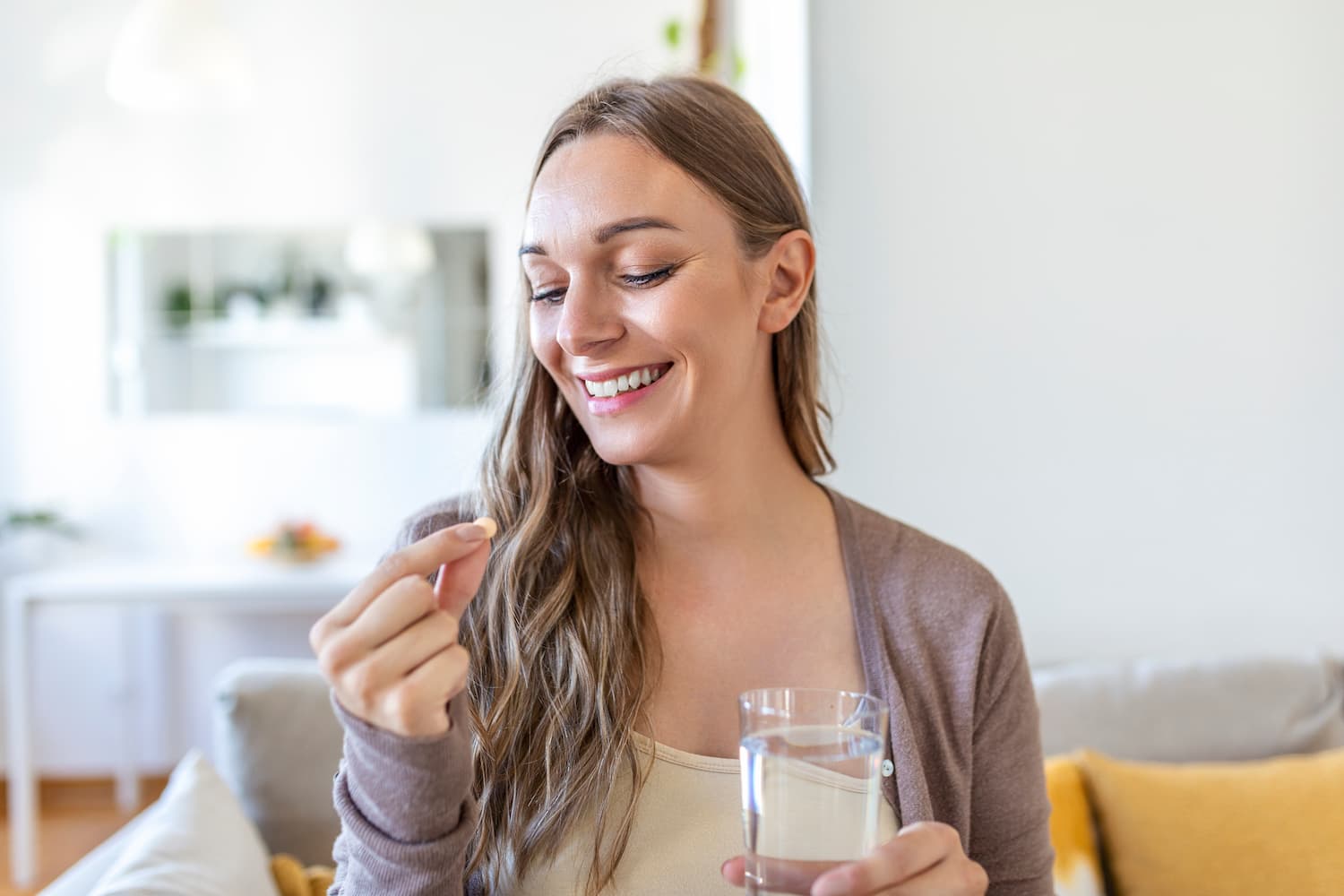
Glutathione is one of the most potent antioxidants for supporting the body's health. Find out how it works and where to get it from.
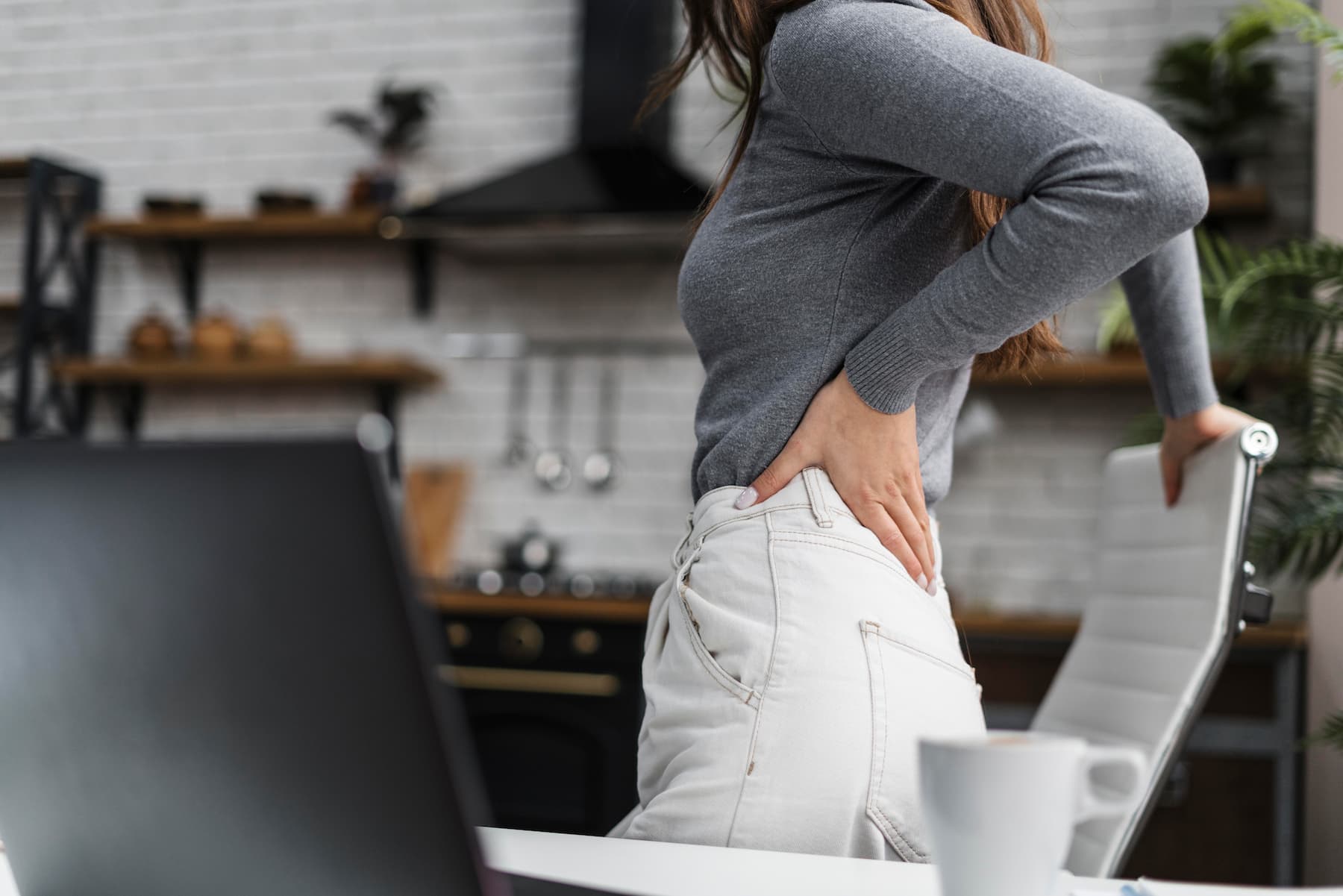
See why hip joints hurt and how to treat their ailments.

